How To Remove Tile Adhesive From Wall
(Last Updated On: sixteen March 2022)
Stick Rock
Adiseal agglutinative & sealant is cracking at agglutinative to stick rock to different items. These include wood, metallic, physical, plastic, tile, cable, polystyrene, masonry, drinking glass & many other items. Adiseal adhesive stone mucilage will work with many different types of rock. Marble, granite, travertine, Indian stone, sandstone & slate to just proper noun a few.
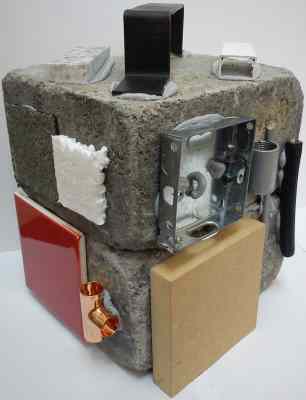
On our concrete demonstration block we take stuck many dissimilar items using Adiseal agglutinative & sealant. We have besides stuck marble to the concrete with Adiseal adhesive & sealant being used every bit a rock gum.
Which stone glue?
There are many adhesives & glues available that can be used to stick stone but to achieve a strong long lasting bond the correct agglutinative or stone glue needs to be used.
Why Adiseal is cracking adhesive for stone
There are many reasons why Adiseal agglutinative & sealant is a smashing adhesive for stone.
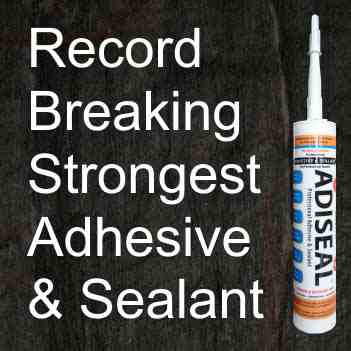
- Adiseal is the tape breaking strongest adhesive & sealant. It proved it'south the best in an independent adhesive strength exam by Ultimate Handyman.
- Adiseal stays permanently flexible so it will absorb any vibration and permit any items to aggrandize & contract without the construction adhesive condign weak.
- Adiseal is waterproof and then it is as well suitable for apply outside. It also seals underwater & glues underwater.
- Priming the fabric should non be required as long as the surface is clean of any dust, grease, paint or any other dirt.
- Information technology does not stain or bleed into stone or masonry.
- Adiseal has very high gap fill properties.
- Has high initial grab significant temporary supports may non exist required while the construction agglutinative cures. Adiseal Hi-Grab has even higher grab than the standard product, come across below for details.
- With Adiseal, the stone does not require sealing prior to applying Adiseal.
In the independent adhesive strength test by Ultimate Handyman, Adiseal was over three times stronger than the nearest competitor. The test on Adiseal was forced to be stopped equally the screws belongings the test rig down started to rip out.
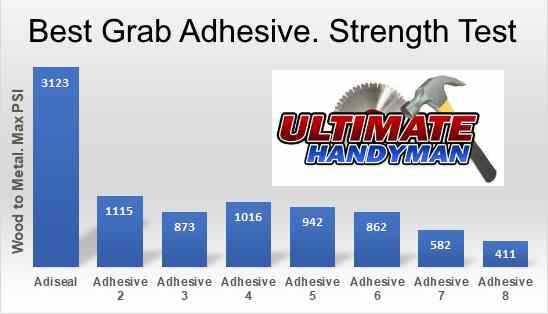
Adiseal Adhesive & Sealant vs Adiseal Hi-Grab
Adiseal agglutinative & sealant has high initial grab but for fifty-fifty more than grab utilize the Adiseal Hi-Grab agglutinative. The final bond strength of both construction adhesives is similar.

Adiseal How-do-you-do-Grab is very useful when trying to bond heavy items to a vertical surface where the item is probable to slide down the surface without temporary supports to agree it until the agglutinative has cured. With the Hello-Grab construction adhesive, the adhesive grabs directly abroad, eliminating the need for temporary supports even in more heavy applications.
Adiseal Hi-Grab likewise has even college gap make full than the standard Adiseal adhesive & sealant. Due to Adiseal Hi-Grab adhesive having a thicker consistency, a lot higher forcefulness is required to button the detail to the surface you are bonding information technology to. For this reason in certain applications the standard Adiseal adhesive & sealant is the better option to get for equally you can reduce the gap between the 2 items existence bonded.
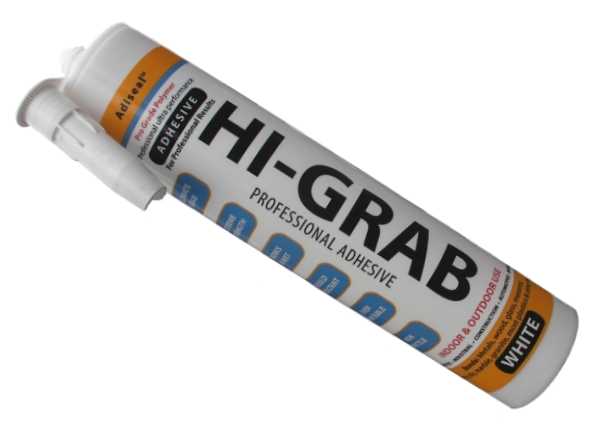
Problems with epoxy adhesives
There are several problems with using epoxy adhesives on stone. Listed below are the principal problems of epoxy adhesives.
- Although epoxy adhesives might initially bond the item to a rock surface, epoxy adhesives are not flexible meaning the bond volition go weaker over time. Air temperature & moisture changes cause items to aggrandize & contract putting extra forces on an adhesive. If the adhesive is non flexible it volition become weak & brittle, then somewhen intermission.
- Epoxy adhesives also come in 2 separate components which require mixing. To attain optimum epoxy adhesive properties, the 2 components need to be the correct ratio therefore crave careful measuring. They as well need to be mixed thoroughly together. If these two are not washed then the optimum properties of the epoxy may non be achieved.
- Epoxy adhesives have lower initial grab than Adiseal, meaning temporary supports will usually be required whilst the epoxy agglutinative cures. This increases time & money with extra labour cost.
Problems with mastic adhesives
Simply similar epoxy, mastic adhesives also have many problems when being used equally an adhesive on stone. Listed below are the main bug of mastic adhesives.
- The main problem with mastic adhesive is that the bond is weak in the 1st place. A mastic agglutinative might be suitable at sticking light items indoors but will fail at more heavy duty applications.
- Another problem with mastic adhesives are they are non waterproof. This ways they are not suitable for use where there will be h2o similar bathrooms, kitchens or outdoors.
- Just like epoxy, mastic adhesives are not flexible meaning the already weak bond will get weaker over time.
- The initial grab of the mastic adhesive is also low meaning temporary supports will be required, increasing time & labour toll.
Bug with contact adhesives
Contact adhesives may be suitable in sticking light sheets to a surface only won't non suitable for more heavy duty applications. There are a number of bug with contact adhesives.
- Contact adhesives have low initial grab meaning temporary supports will be required until the adhesive has cured.
- Contact adhesives also has low gap fill up meaning if there is a gap in certain places betwixt the 2 surfaces of the items being bonded, the contact adhesive will non stretch betwixt the 2 surfaces. This will create a much weaker bond as merely in a few places where the surfaces are very close together volition the agglutinative successfully bond.
- As stone is porous it volition require sealing first then that it does not soak up whatever contact adhesive.
Bug with using mucilage on stone
Glues are generally suitable at sticking modest items to polish surfaces only not for more heavy duty applications like bonding items to stone. For more than heavy duty applications, a construction adhesive like Adiseal will exist required. Glues have lower gap fill, initial grab, bond strength, flexibility & other problems compared to Adiseal adhesive & sealant when trying to stick items to stone. As stone is porous it will require sealing starting time so that it does not soak upward any mucilage.
How to bail wood to stone
Adiseal will successfully bond both softwood & hardwood to stone creating a strong & long lasting bond in both interior & exterior applications. Prior to applying the agglutinative, it is vital to accept clean surfaces where the agglutinative will be applied. Make sure both surfaces are free from whatsoever dust, grease, paint or whatever other dirt. We recommend using a fine brush like a painting brush to remove fine dust.
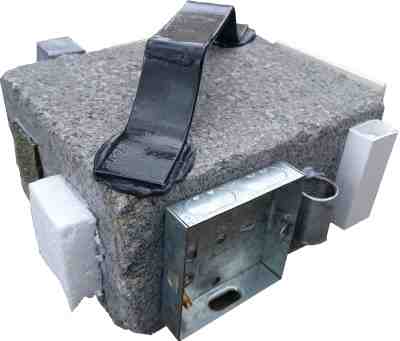
On our physical demonstration block shown above, before applying the adhesive we accept thoroughly brushed the concrete using a paint brush to brand sure any dust is removed.
Later the surfaces are make clean, with forest simply apply the adhesive to either material and firmly push it onto the stone. If there is potential of water in the area the item is beingness bonded to, Adiseal needs to be applied in sparse vertical strips. This allows any water to run downwardly between the strips instead of edifice up backside the item. In common cold temperatures water will turn to water ice which expands and pushes the surfaces apart.
In that location should be no need for temporary supports merely if the woods does start to slide, and then temporary supports may exist required until the adhesive has cured.
Woods tends to soak up moisture in the air meaning it will aggrandize. Using a flexible adhesive when sticking wood to stone is very important.
For safety reasons on actress heavy wood, mechanical fixings also need to be used in conjunction with Adiseal when used on to bond items to vertical & overhead applications.
Adiseal volition successfully bond all metals to stone in interior & exterior applications. As described in a higher place, it is vital to have clean surfaces where the agglutinative will be practical to.
Some metals may have an oil applied to information technology to stop the metal from rusting. This oil needs to be removed before the agglutinative tin be applied to the metallic surface. Adisolve is platonic at removing oil, grease, tar & many other stubborn deposits.
To accomplish a strong bond, lightly scratch the surface of the metal where the adhesive will be practical to. This will increase the surface surface area allowing for a stronger bond. Clean the surface thoroughly after scratching the surface to remove whatsoever loose metal.
In one case the surfaces are clean, simply apply the agglutinative and firmly push the metal to the stone. Temporary supports may exist required if the items slide downwards, or utilize the Adiseal Hullo-Grab adhesive for more than grab.
For prophylactic reasons on extra heavy metal items, mechanical fixings also need to be used in conjunction with Adiseal when used on to bond items to vertical & overhead applications.
How to bond plastic to stone
Adiseal is suitable at bonding most types of plastics to stone. Every bit with metal, clean the plastic thoroughly to make certain any dust, oil, grease, paint or whatsoever other dirt is removed before applying the adhesive. Scratching the surface of the plastic will increase the surface expanse increasing the strength of the bail between plastic & stone.
After both surfaces are clean, employ the adhesive firmly & press the item onto the stone.
Adiseal is also great when used to glue bogus grass to stone.
How to bail rock, brick, tile or masonry to physical
How to glue stone to different materials.
- Clean surface.
Adiseal is suitable at sticking stone, brick, tile or masonry to concrete in interior and exterior applications. Castor of whatever grit thoroughly prior to applying the adhesive. With Adiseal, priming of the stone, brick or masonry is commonly non required as long as the surfaces are thoroughly clean. We recommend using a fine brush like a painting brush to remove fine dust.
- Sealing stone?
A common problem when using other adhesives or mucilage for stone is they tend to bleed into the stone, as stone is a porous material. Instead of using these other adhesives or glue for stone, using Adiseal will avoid this problem.
- Apply stone glue or agglutinative.
Apply the stone glue or agglutinative to 1 surface and firmly push the items together.
- Agree rock in place.
Temporary supports may exist required if the items starts to slide down. Adiseal tin have 24 to 48 hours to fully dry out. It has high initial grab only for even more instant take hold of use the Hullo-Grab product.
- Remove excess.
Wipe away any excess stone agglutinative or glue. Adiseal can be simply wiped away with a cloth. Use Adisolve to help remove and uncured Adiseal.
For safety reasons on extra heavy stone, brick, tile or other masonry items, mechanical fixings besides need to exist used in conjunction with Adiseal when used on to bond items to vertical & overhead applications.
Glue for stone
Information technology is also possible to glue rock using our Adiglue. Although Adiglue is less brittle than super glues, it is still not equally flexible or strong as Adiseal construction adhesive & construction sealant.
In the example below we accept glued a metal handle to a heavy concrete slab with the Adiglue glue. The concrete required sealing first with Adiglue Activator and so that it does not soak up the Adiglue. Sealing is non required when using Adiseal construction adhesive & construction sealant to stick the same metal handle to concrete or stone.

We have also stuck some bricks together & also brick to MDF with Adiglue to demonstrate what it is capable of. Sealing with Adiglue Activator was required first prior to applying the glue.

Glue for Marble
Adiseal & Adiseal How-do-you-do-Grab are great adhesives when used equally marble agglutinative or glue for marble. When using Adiseal or Adiseal Howdy-Grab to glue marble, make certain both surfaces are thoroughly clean to get the strongest bail. Sealing the marble is not necessary on the surface where the adhesive volition exist applied. Once the surface is thoroughly clean, apply the adhesive to 1 surface and button the marble onto the other surface.
Temporary supports may be required until the agglutinative has cured. When the marble is stuck on vertical or overhead applications, mechanical fixings are recommended together with the adhesive for condom reasons.
Every bit explained above it is also possible to apply Adiglue to glue marble, simply it won't be as stiff or flexible as Adiseal or Adiseal Hi-Grab adhesives. If using Adiglue to glue marble, the marble will crave sealing offset with Adiglue Activator earlier applying Adiglue. This is non required for Adiseal adhesive & sealant or Adiseal Hi-Grab.
To get the strongest possible bail with any gum for marble, making certain both surfaces are clean is very important. We recommend brushing the marble surface with a fine brush like a painting brush to aid remove fine dust.
Adhesive for Granite
Adiseal & Adiseal Hi-Grab are bully adhesives when used agglutinative for granite or glue for granite. When using Adiseal or Adiseal Hi-Grab to mucilage granite, brand certain both surfaces are thoroughly make clean to go the strongest bond. Sealing the granite is not necessary on the surface where the adhesive will be practical. Once the surface is thoroughly clean, apply the adhesive to 1 surface and push the granite onto the other surface.
Temporary supports may exist required until the adhesive has cured. When the granite is stuck on vertical or overhead applications, mechanical fixings are recommended together with the adhesive for safety reasons. As explained above it is also possible to use Adiglue to glue granite, but it won't be as potent or flexible equally Adiseal & Adiseal Hi-Grab adhesives.
Adhesive for Slate
Adiseal & Adiseal Hullo-Grab are bang-up adhesives when used adhesive for slate or gum for slate. When using Adiseal or Adiseal Howdy-Grab to glue slate, make sure both surfaces are thoroughly clean to go the strongest bail. Sealing the slate is not necessary on the surface where the adhesive will exist applied. Once the surface is thoroughly make clean, use the adhesive to 1 surface and push the slate onto the other surface.
Temporary supports may be required until the agglutinative has cured. When the slate is stuck on vertical or overhead applications, mechanical fixings are recommended together with the adhesive for safety reasons. As explained above it is besides possible to apply Adiglue to glue slate, but it won't be as strong or flexible as Adiseal or Adiseal Hi-Grab adhesive.
Adhesive for Indian Rock
Both Adiseal adhesive & sealant and Adiseal Hi-Grab are suitable at bonding Indian stone to many unlike materials. As Indian stone is a porous material, not all adhesives are suitable working with Indian rock. Adiseal adhesive & sealant and Adiseal Hi-Grab do not drain through or stain the Indian stone. They will provide a good stiff bond on Indian stone that volition remain waterproof & flexible.
How to bond Indian Stone
Making sure both surfaces are thoroughly clean is important to getting a good strong bail. We recommend brushing any debris off and so going over it over again with a effectively castor like a painting brush to make certain whatsoever dust is also removed. Apply the product to one surface so push button both materials together. Temporary supports might be required as it can take 48 hours for the product to cure.
For more information on adhesives visit our detailed guide on adhesives page.
Oft asked questions most sticking stone
What is the all-time gum for rock?
Adiseal is the best agglutinative to use on stone every bit information technology has proven to be the strongest adhesive by an contained adhesive force test. Adiseal is flexible, waterproof, loftier gap fill, high grab, UV resistant and sticks nigh any type of fabric to stone.
How to apply stone adhesive?
To apply rock adhesive, making sure both surfaces are make clean of any dust, grease, paint and any other dirt is vital before applying the adhesive on to the surface of the detail being stuck to the rock. Adiseal has good initial grab but Adiseal Hi-Grab has even higher initial catch.
If temporary supports can exist used then it is recommended to use the standard Adiseal Adhesive for a closer bond.
How to remove stone adhesive?
To remove adhesive from rock, use a sharp item similar a knife or chisel. Unremarkably chemical adhesive removers volition non have any touch on on stone adhesive.
Does stone need sealing before applying a glue or adhesive?
As stone is a porous material, information technology will soak up whatsoever liquid glue or adhesive. With Adiseal this is not required as Adiseal will not soak into the stone. If the stone does crave sealing for use with other adhesives, apply the Adiglue Activator to seal it.
What is the best exterior rock adhesive?
The best outside rock adhesive is Adiseal. It is flexible, waterproof, high gap fill, high grab, UV resistant and tin be painted over. It works in the dry, wet and fifty-fifty underwater. In an independent exam, Adiseal has proven to be the strongest agglutinative.
How To Remove Tile Adhesive From Wall,
Source: https://adiseal.com/stick-stone/
Posted by: gemmillyouser.blogspot.com


0 Response to "How To Remove Tile Adhesive From Wall"
Post a Comment